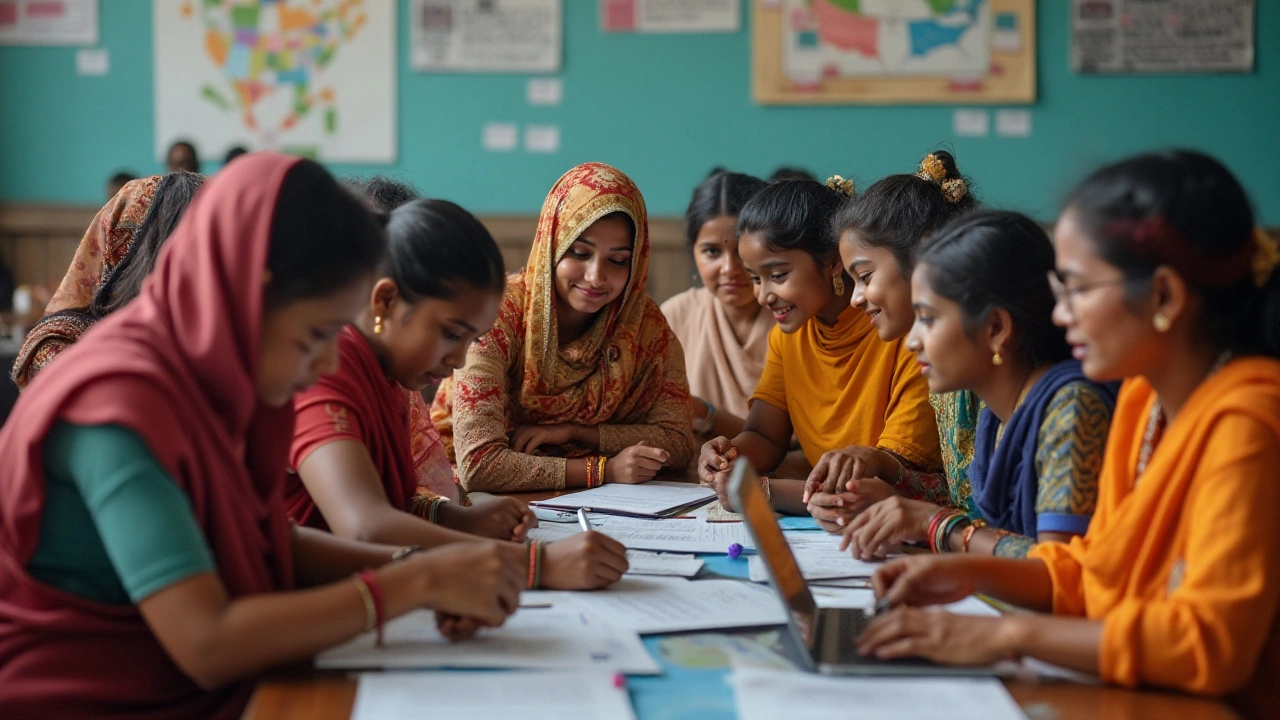In a world that constantly evolves, vocational training stands as a beacon of empowerment, especially for women. This transformative education model equips women with the practical skills and knowledge necessary to thrive in numerous industries. From healthcare to technology, vocational programs open doors to careers that might otherwise remain inaccessible.
However, understanding the roots of vocational training reveals a journey marked by significant milestones. Women's participation in these programs has been pivotal, breaking barriers and challenging societal norms. Today, the landscape has expanded with strides in diversity and inclusion, offering an array of opportunities for women across the globe.
It's important to discuss the impact of vocational training on women's lives, unveiling stories of success and growth. By examining these narratives and the available programs, we can paint a picture of resilience and potential, showcasing the benefits that extend beyond individual success to uplift entire communities.
- Historical Context of Vocational Training for Women
- Benefits and Opportunities
- Current Programs and Success Stories
- Overcoming Challenges and Inspiring Future Growth
Historical Context of Vocational Training for Women
Understanding the journey of vocational training for women requires a deep dive into the past. The roots of structured skill development date back centuries, yet it was not until the industrial era that formal vocational education began to take shape. During the 19th century, societal norms typically relegated women to the roles of homemakers and caregivers. However, as the demand for skilled labor increased, opportunities for women slowly emerged, challenging these traditional roles.
The early 20th century marked a turning point with significant movements in women's empowerment. The rise of the suffragette movement directly correlated with increased access to education and career opportunities. Women began gaining entry into training programs, albeit often limited to fields stereotypically associated with female labor, such as textiles and domestic sciences. Despite these constraints, these programs sowed the seeds for future growth and diversification.
World War II was a catalyst for change. With men conscripted into military service, women entered the workforce in unprecedented numbers. Training programs expanded to include women in sectors traditionally dominated by men, such as manufacturing and engineering. This era highlighted women's capabilities and significantly altered public perceptions, driving further institutional support for women's vocational education in the post-war years.
"The advent of women into trades during the war highlighted a simple but profound truth — skill knows no gender," said Rosie Bendix, an influential advocate for women's workforce equality in the mid-20th century.
The latter half of the 20th century saw continued progression, as activism and education policy increasingly championed skill development as a means to achieve gender equality. Vocational training programs diversified, offering women access to a broader range of disciplines and paving the way for today's utterly dynamic educational landscape.
- 1960s: Introduction of federal laws ensuring equal educational opportunities for men and women.
- 1970s: Rapid growth in technical courses available to women, including IT and electronics.
- 1980s: Organizations worldwide started recognizing the crucial role of women in skilled trades
- 1990s: Rising awareness and initiatives for women in leadership and entrepreneurship training.
Today, these programs have broadened even further, encompassing initiatives that support entrepreneurial skills and technology training, uniquely positioning women in emerging markets. The historical journey of women's vocational training serves as both a testament to resilience and a blueprint for future empowerment. As we continue to unravel these rich layers of history, it becomes evident that each step forward not only redefines success for women but reshapes industries for generations to come.

Benefits and Opportunities
The world of vocational training is a gateway to numerous benefits and opportunities, particularly for women seeking to break into male-dominated fields or those looking for better career options beyond traditional roles. The first and foremost benefit is the acquisition of practical, hands-on skills, which equips them with capabilities that are directly applicable in the workforce. Unlike conventional academic paths, vocational training typically involves a targeted approach to learning—one where the outcome is aligned closely with industry requirements. This means that women can fast-track their entry into the workforce, often bypassing years of theoretical education that might not result in immediate employability.
This form of training is especially crucial for women in developing countries, where access to education and employment opportunities may be limited. It provides them with a chance to gain economic independence—a feat that can dramatically shift power dynamics in their communities and enhance their social standing. Many women have been able to support themselves and their families through vocational skills in trades such as nursing, technology, culinary arts, and fashion, creating a ripple effect of improved quality of life.
Another significant opportunity offered by vocational training is bridging the skills gap that exists in many industries. Companies across the globe are faced with the challenge of finding skilled labor, and vocational training programs are increasingly stepping in to fill these gaps. For instance, a woman who graduates from a software development vocational program might find herself immediately in demand as countries strive to foster digital economies. This not only creates immediate employment opportunities but also contributes to the long-term stability and growth of industries.
Moreover, the economic benefits cannot be overstated. According to a study by the International Labour Organization, women who engage in vocational training can increase their employment rate by as much as 8-25%. This boost in employability often translates into higher lifetime earnings, providing a foundation for financial security. As they take on roles that offer sustainable incomes, women gain the ability to invest back into their families and communities, fostering a cycle of prosperity and growth.
| Country | Employment Increase (%) |
|---|---|
| India | 12% |
| Kenya | 20% |
| Brazil | 15% |
"Vocational training is the key to bridging the gender gap in employment and giving women the dignity of choice in their careers," says Dr. Amara Malik, an advocate for women's education.
The empowerment that comes through learning and mastering a trade or skill also translates into increased confidence and autonomy for women. When they feel self-assured and capable, they are more likely to take on leadership roles in their workplaces and communities, paving the way for future generations of women leaders. This personal growth is invaluable and often serves as the foundation upon which women build both professional and personal success.

Current Programs and Success Stories
Vocational training has seen a remarkable evolution, particularly in how it serves to empower women worldwide. Today, numerous vocational training programs cater specifically to women's needs, promoting education that aligns with today's job market demands. These programs not only aim to equip women with tangible skills but also inspire self-sufficiency and confidence. In different corners of the world, initiatives are thriving, making a tangible difference in the lives of countless women.
One notable initiative is the Women's Emporium in Bangladesh, which has successfully trained thousands of women in textile and garment manufacturing. Women who once faced limited career opportunities are now becoming prominent figures in the global textile sector. Each year, hundreds of graduates make their way to well-paying jobs that promise stability and financial independence. Another remarkable case is the SheTrades initiative in Kenya, which connects women entrepreneurs with international markets, offering training in digital literacy and e-commerce strategies. By implementing interactive workshops and mentorship programs, SheTrades has successfully altered the course for numerous women, opening doors once thought closed.
Such impactful stories are echoed in programs like the SEWA Cooperative Federation in India. By training women in the basic principles of banking and microfinance, they have created channels for women to become leaders in their communities. The Federation has not only expanded financial literacy among women but has also inspired entrepreneurial ventures driven by fueled ambition and newfound skills. It's a living testament to how vocational programs can revolutionize a community by offering women a platform to grow and succeed.
According to data from the International Labour Organization, more than 70% of these vocational training graduates find gainful employment or start businesses within six months of program completion. This statistic sheds light on the immense potential and success of vocational training focused on women. The transformative nature of these programs has made vocational training a sought-after path for personal and professional development across the globe, showcasing varied success stories that built a foundation of hope and ambition.
"Empowering women through vocational training creates not only a better society but a better world where every woman can fulfill her potential," stated Phumzile Mlambo-Ngcuka, former Executive Director of UN Women.
The impact of these success stories is not only personal but also social. Communities have benefitted immensely from women entering the workforce, contributing to a more balanced and productive society. Skills learned through these programs translate into innovation and entrepreneurship, reflecting how vocational training serves as an essential catalyst in transforming women's roles across industries.
However, the journey doesn't stop with these successes. There are still numerous untapped opportunities in vocational sectors requiring more attention and resources. By highlighting these stories and programs, we hope to inspire more stakeholders to invest in vocational education, leading to the sustainable development and empowerment of women worldwide.

Overcoming Challenges and Inspiring Future Growth
Embracing vocational training for women hasn't been without its challenges. Cultural and societal norms have often acted as barriers, limiting access to education and professional growth. In many parts of the world, traditional gender roles discourage women from pursuing careers outside the home, thereby restricting their economic independence. Despite these obstacles, vocational training has gradually gained acceptance as a vital tool for women's empowerment, evolving towards inclusivity and diversity. The journey has been shaped by advocates and organizations striving to dismantle stereotypes and promote equal opportunities.
One of the most formidable challenges lies in changing perceptions at the community level. Education is key, but so is the support from family, peers, and the broader community. Campaigns have been launched to highlight the benefits of women's participation in vocational training, including improvements in their quality of life and economic contributions to society. By showcasing female role models who have succeeded through vocational training, these campaigns inspire others to follow suit. Effective storytelling, focusing on the triumphs and struggles of real women, plays a crucial role in shifting mindset, proving that women can excel in fields traditionally dominated by men.
Another hurdle is the availability and accessibility of training programs. In rural or underprivileged regions, resources are often scarce, and educational facilities are limited. Governments and NGOs have been pivotal in developing infrastructures that cater to these areas, ensuring that all women, regardless of their geographical location or financial status, have access to quality vocational education. Scholarships and financial assistance programs have been developed to aid those in need, removing economic barriers that could deter women from enrolling in vocational courses. With technology playing a significant role, online platforms have emerged as an innovative solution, amplifying the reach of vocational programs.
Inspiring Future Growth
"The only way to break the cycle of poverty is through education," says Malala Yousafzai, a renowned education activist who has tirelessly advocated for girls' right to learn. Her words resonate deeply within the realm of vocational training, as the approach not only equips women with skills but also fosters self-reliance and self-confidence.
Looking to the future, collaboration and partnerships remain essential. Public-private partnerships can drive growth, combining resources and expertise from various sectors to expand and improve training programs. Aligning vocational training curricula with the evolving demands of the job market ensures that women receive relevant education that meets industry standards. Programs focusing on emerging industries, such as digital technologies and renewable energy, are critical in preparing women for the future workforce, offering them a competitive edge.
Success stories of women transforming their lives through vocational training continue to inspire others. Testimonials from graduates who have secured employment or started their own businesses highlight the tangible benefits of vocational education. These stories underscore the transformative power of skill development and amplify the message that investing in women's vocational training yields significant returns. By fostering an environment where women can thrive through vocational education, we create a more diverse, inclusive, and sustainable world.
